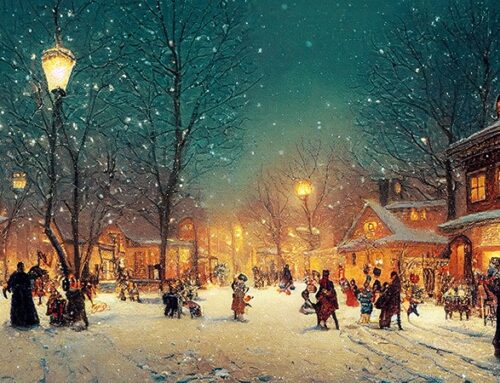According to The Week, the US uses an average of 6.63 billion kWh of electricity each year on Christmas lights – more than the entire annual consumption of El Salvador (5.35 billion kWh) and Ethiopia (5.30 billion kWh), and spends US$ 199-573 per household on electricity during the holiday season versus a typical monthly expenditure of US$ 114. is around $114.
It is widely believed that the 16th century protestant reformer, Martin Luther, began the tradition of lighting Christmas trees, by tying candles to the branches of his tree, after becoming entranced by the sight of stars twinkling between the evergreens on his walk home one evening. The tradition of bringing decorated trees into homes for Christmas originated in Germany in the 16th century, and gradually spread across the Christian world, becoming popular on both sides of the Atlantic in the 19th century.
The rather hazardous practice of attaching candles to Christmas trees for light continued until well into the 20th century, despite the invention of strands of lights by Thomas Edison in 1880. The first use of such lights for decoration was in 1882, when Edward Johnson, vice president of the Edison Illuminating Company, hung 80 blinking red, white, and blue hand-wired lights around a rotating Christmas tree in his home, and enchanted passersby. A reporter from the Detroit Post and Tribune described the spectacle as:
“a continuous twinkling of dancing colors, red, white, blue, white, red, blue — all evening. I need not tell you that the scintillating evergreen was a pretty sight — one can hardly imagine anything prettier.”
Interestingly, Christmas tree lights were invented all over again in 1908, when Ralph Morris, an employee of the New England Telephone Company had the idea of pulling the lights from an old telephone switchboard and wiring them on a tree after seeing his son push a candle over on a Christmas tree, almost setting the tree on fire and singeing his hair.
President Grover Cleveland used lights on the White House Christmas tree in 1895, and overnight, electric Christmas tree lights became a national sensation, helping to overcome the popular fear at the time, that dangerous vapours would seep into homes through the electric lights and wires. However their expense made them out of reach for most people – it cost about US$ 300 (around US$ 2,000 in today’s money) to light a single tree, as each individual light had to be wired by an electrician.

In 1903, the General Electric Company started selling pre-assembled kit consisting of eight green pre-wired porcelain sockets, eight Edison miniature base coloured glass lamps, and a handy screw-in plug for easy attachment to a nearby wall or ceiling light socket that could be rented from some department stores for about US$ 1.50 a strand. When GE attempted to patent their Christmas “festoons,” their application was refused because the product was based on knowledge that ordinary electricians possessed.
However, candles continued to be the most popular means of lighting Christmas trees, until a tragic fire in New York City in 1917 gave 15-year old Albert Sadacca the idea of adapting the novelty lighting his parents sold for Christmas trees. Only a hundred strings of lights sold in the first year, however after Albert started to paint the lights in different colours, the business began to take off. Sadacca subsequently founded the snappily-named National Outfit Manufacturers Association, a trade group of several small companies that consolidated into the NOMA Electric Company in 1926. NOMA was the largest Christmas light company in the world until the mid-1960s.
Unfortunately, many of the earliest Christmas lights burned so hot that they were about as dangerous as the candles they were advertised to replace.
A key property of modern Christmas lights is the ability to twinkle. Twinkling lights were first introduced in the 1920s, consisting of a simple thermostat – once the lights were plugged in, a strip of metal inside the bulb was heated until it bent, breaking the circuit and extinguishing the light. As the light cooled down, the strip of metal bent back, re-connecting the circuit and re-lighting the light. Modern lights use an integrated circuit, and, while the bulbs are still connected in series, a shunt within each bulb prevents the entire string of lights from going out if one bulb fails. The bulbs are also generally now LEDs with much longer lifetimes than their incandescent predecessors.

Early Christmas lights were elaborate, depicting fruit, flowers and holiday figures which were blown from the same moulds that were also used to make glass ornaments, and then painted by toy makers. The paint would often flake from the constant expansion and contraction of the glass, so milk glass was typically used to make the flaking paint less noticeable. The industry quickly and almost exclusively switched over to the use of the white milk glass by the late 1920s.
There was a common but incorrect belief in the early days of electric Christmas lighting that Christmas light bulbs would burn longer in an upright position, so early tree decorators wasted a lot of time ensuring the lamps were positioned upright on the tree.
True outdoor Christmas lights were not introduced to the public until 1927 – almost 45 years after the first electric tree lights were demonstrated. There were sets offered for sale as safe to use outside before 1927, but they were small, dangerous and extremely impractical for the average family.
To increase sales of the lights, General Electric and various distribution companies sponsored neighbourhood “decorating with colour-light” contests, a tradition that continues today, however, some neighbourhoods are glad to see the back of them after the end of holiday season – residents of Aurora in Illinois face a fine of US$ 50 if they do not take down their lights by 25 February.
The use of electric Christmas tree lights became widespread after the second world war, and the use of candles was all but extinguished. My grandparents still liked to decorate their Christmas trees with candles, but actual illumination came from electric tree lights.
I would like to take this opportunity to wish all of my readers a relaxing holiday season, and a happy and prosperous New Year!






Thank you for this very topical article. It goes well beyond what can be gleaned on Wikipedia.
Happy New Year. Looking forward to more of this blog!
This custom was borrowed from pagan yule rituals that celebrate the return of the light of the sun as the days grow longer after solstice: the evergreen trees symbolizing the renewal and continuance of life in dark times. The Christmas trees were brought by Christians into their homes in early modern Germany. This makes LED lights more efficient, durable, and longer-lasting than fluorescent incandescent lights.
Kent Fire and Rescue Service’s (KFRS) 2018 festive safety campaign calls on people to be smart about home safety and to avoid becoming the ‘Grinch’ who stole Christmas.